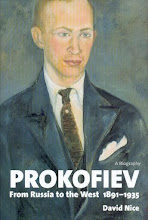
You reckon you know, and in terms of what Puccini, Giacosa and Illica wanted from the first Roman location of Tosca, you'd be right: the huge Church of Sant'Andrea della Valle near the Campo dei Fiori and the Palazzo Farnese. When I last went inside some years ago, I didn't find it up to the artistic scratch of its other grandiose near-neighbours, Sant'Ignazio or the Gesu. But I read that Domenichino had a hand in the decoration, so maybe I need to take another look.
The point, though, is that productions like Catherine Malfitano's generally clear and human one for ENO (Gwyn Hughes Jones's Cavaradossi and Henry Waddington's Sacristan pictured above by Mike Hoban) don't need to aim for massiveness when Sardou's original play gives them another cue. His first directions are for 'The Saint Andrew of the Jesuits Church in Rome'. By which he means the much smaller, more perfect church of Sant'Andrea al Quirinale.

Sardou continues: 'Architect Bernini: fully curved arches above large plain pillars of white marble with red veneer'. So he knew it; and I do, too, and love its oval perfection almost as much as Borromini's San Carlo alle Quattro Fontane just down the road. But again I haven't been inside for some years, so I'm grateful for these Wiki images.

Changing the location does give a designer the option for a tighter, less blowsily Baroque setting for Act 1. But of course the several Toscas filmed on location always use the bigger church. Why, in these, does Domingo's Cavaradossi have to be such a bad artist? In the first film, with dubbed soundtrack (but better singing) his Attavanti Magdalen is a piece of Woolworth's soft porn. Never mind the 'art'; feel the quality of the singing.
And enjoy Gigli as a lighter Cavaradossi, though I've come across none - and we heard about ten snippets from various 'Recondita armonia's in the second of our five Tosca class at the City Lit - who sings the opening piano against dolcissimo strings as requested.
I'm most in love with the blooming, sensuous love-triangle of Carreras, Ricciarelli and Karajan among the sound recordings of this act. What ardour in the second half of the love duet.
Anyway, on my four-hour trek across Rome, I did suddenly think I should pay homage once more to each of the opera's venues. Sant' Andrea della Valle was closed at 3pm, of course, but here's another, this time rather modest Roman fountain before it.

Next time a tour of the Palazzo Farnese - apparently they're more frequent than they used to be - is essential to see Annibale Carracci's profane ceiling fresco celebrating 'the triumph of love' with the coruscating cortege of Bacchus and Ariadne, well evoked in Robert Hughes's Rome.

Where Scarpia's room might be is an irrelevance. Again, in Sardou's La Tosca Act 4, it's a much sparser affair in the Castel Sant'Angelo; in Act 2 we have the grand Farnese reception which takes place offstage in the opera, complete in the play with Queen Marie-Caroline of Naples (who faints at the news of Napoleon's victory), the Marquis Attavanti and Paisiello. A sun-lit sidewall

and the back view from the Via Giulia

should ring the changes. And finally, of course, the Castel Sant'Angelo once again, which glowed rather benignly in the late afternoon sun.
















